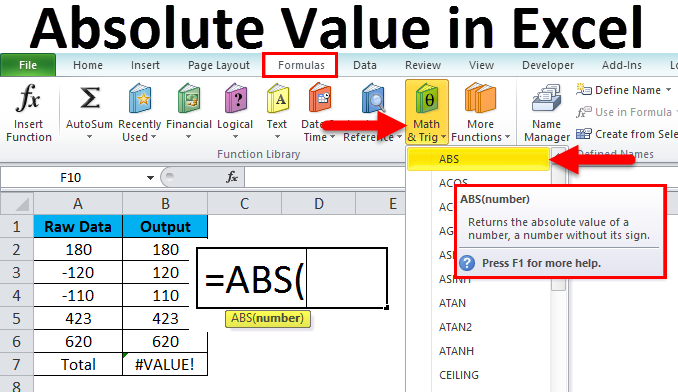


how much time most sprinters are expected to take to complete the race. For example, if a few athletes have run a 100m sprint, you may want to know the average result - i.e. In plain English, calculating the average for a set of values if finding out the most common value in the set.

#What is the absolute value function on excel 2011 for mac how to#
You will also learn how to use the AVERAGEIF and AVERAGEIFS functions to average cells that meet certain criteria. If you want some more Excel tips, keep reading & Magoosh also offers Master Excel: Beginner to Advanced to improve your Excel skills.The tutorial shows how to calculate mean in Excel for different data types by using AVERAGE or AVERAGEA formulas. I hope this article has made you a master of absolute and relative references. This allows you to cycle through the different types of absolute references if you press it multiple times while typing the formula. One more quick tip before you go: on your keyboard, the shortcut to making cells absolute is to press F4 while editing in the formula bar. However, if you copy and paste that formula into A4, it stays =A$1+A$2 because its row references are absolute. If you type =A$1+A$2 into cell A3, then copy and paste that formula into cell B3, you’ll get =B$1+B$2.

Absolute RowsĬonversely, you can make the rows but not the columns absolute. When I get confused by this, I think about it as if I’m “freezing” the columns so that my cell always references column A, no matter where I copy and paste it or drag it down. That’s because the column references are absolute, but the row references aren’t. But if you copy and paste that formula into A4, then it becomes =$A2+$A3. If you type =$A1+$A2 into cell A3, then copy and paste that formula into cell B3, it will stay =$A1+$A2. If you type =$A$1+$A$2 into cell A3, then copy and paste that formula into cell B3, it will stay =$A$1+$A$2. Absolutely AbsoluteĪll dollar signs, baby. So if you type =A1+A2 into cell A3, then copy and paste that formula into cell B3, it will automatically change the formula to =B1+B2. No dollar signs at all! If you copy this bad boy from place to place, the formula will move with it. (Note that I’m not using the official names here, but I’m hoping “absolutely absolute” catches on.) Relative References I recommend opening up your own blank Excel sheet to follow along. Knowing this information, there are four types of references you should know. (Actually, the formula can also look like =$A1+$A2 or =A$1+A$2, but let’s not get ahead of ourselves.) So a relative cell reference might look like =A1+A2 but an absolute reference might look like =$A$1+$A$2. Absolute references are noted by a dollar sign in front of the cell reference. The key difference between relative and absolute cells is that relative cell references move when you copy them, but absolute references do not. Knowing the difference between absolute and relative references in Excel can take you from Excel novice to master in not long at all. Is it important to know the difference between relative and absolute references in Excel? Absolutely! Pardon the pun, but I couldn’t resist it. By Rich Rinaldi on Decemin Basic Excel Functions and Formulas


 0 kommentar(er)
0 kommentar(er)
